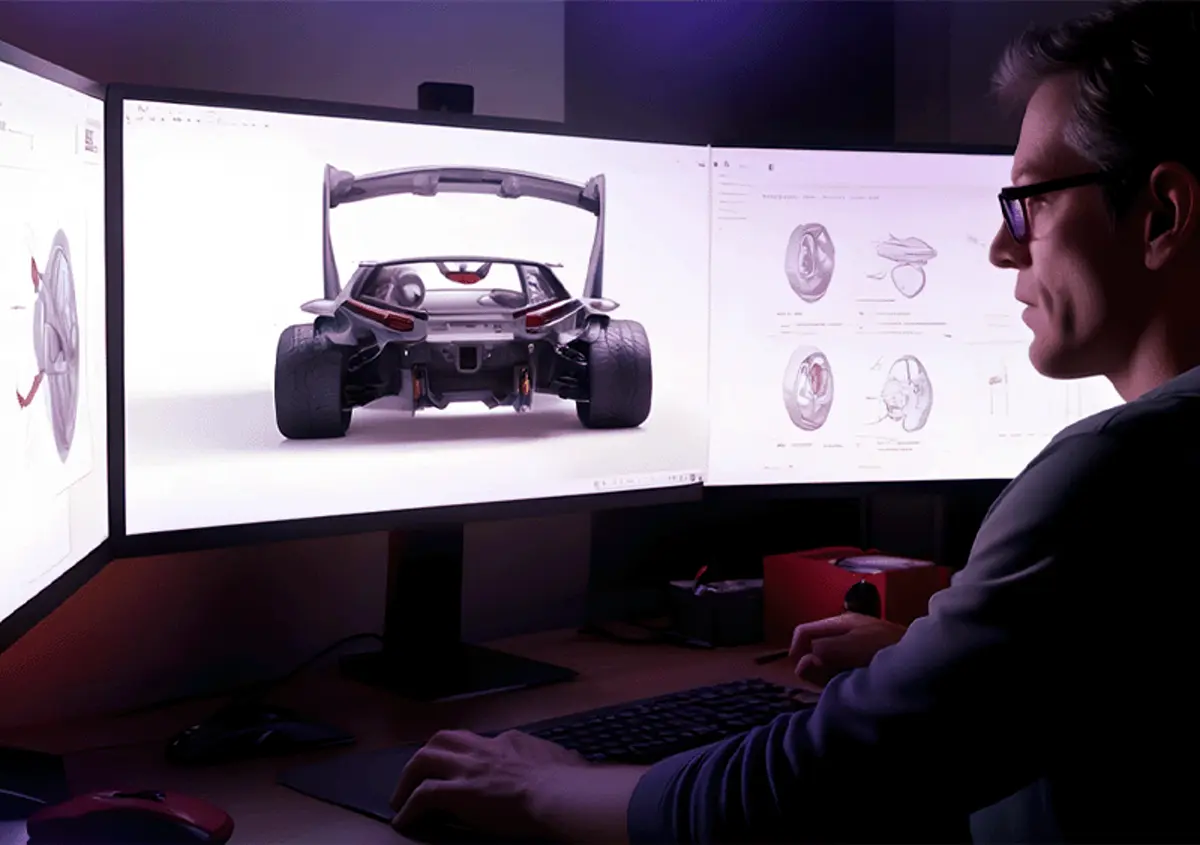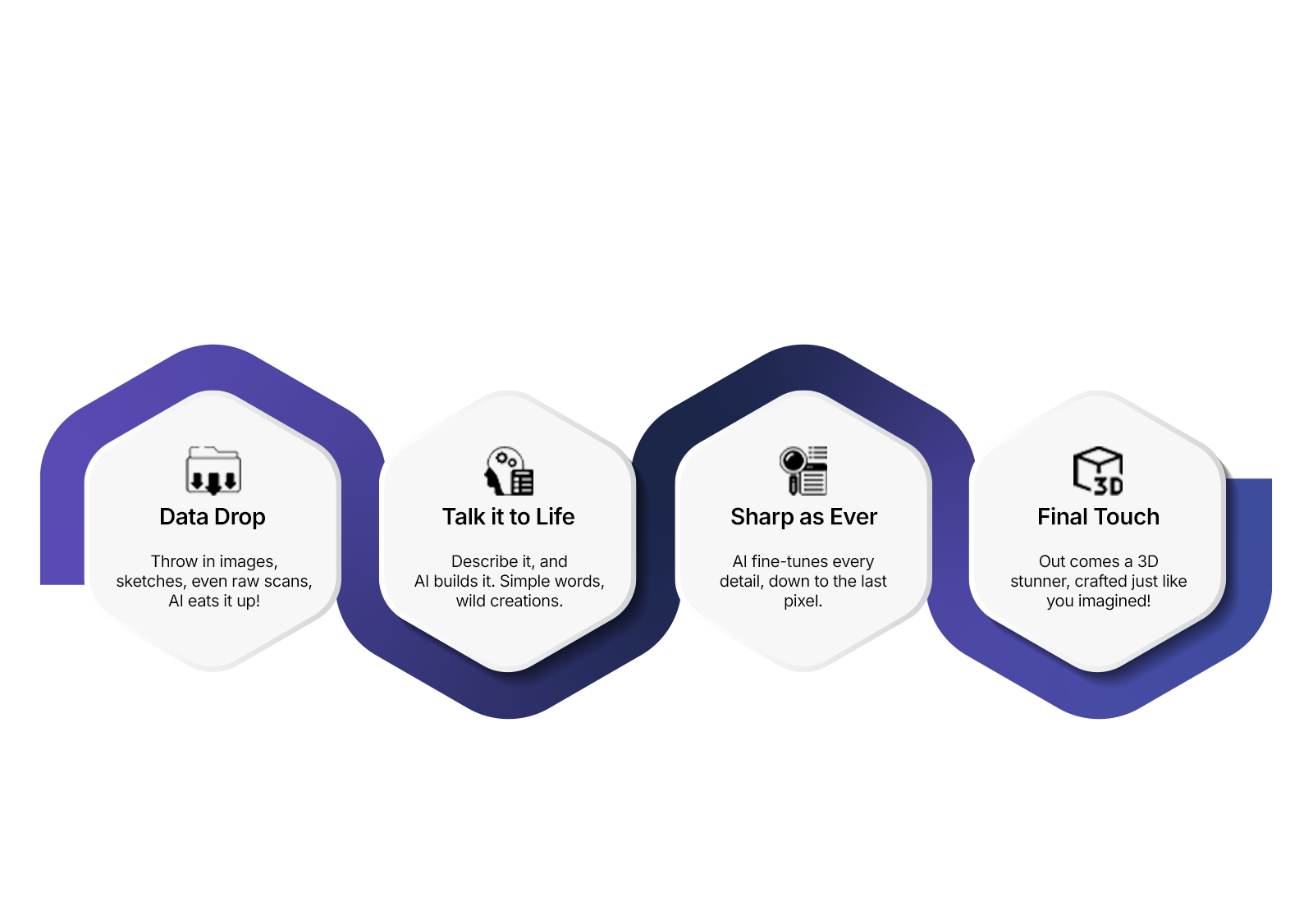Is AI Ready to Make Quality 3D Models? Answer Revealed!
Find out how close AI is to matching human-crafted 3D models today

5 MIN READ
Published October 01, 2024

Written By
Sasikumar Janakiraman
AI is transforming industries, and 3D modeling is no exception. Imagine needing a high-quali ty 3D modeling services for gaming and architectural visualization. AI now makes it possible to generate these models in a fraction of the time it would take a human. But speed alone isn't everything. So, how does AI stack up when it comes to matching the artistry and detail of models crafted by humans?
This blog will walk you through what AI can currently achieve in 3D modeling, how it compares to human-made models, and when we might expect AI to fully meet the high standards of top industries.
How AI Builds 3D Models
Creating 3D models with AI might sound complex, but let's break it down step by step.

-
1. Starting with Data
AI learns from data — TONS of it. To generate 3D models, AI needs to understand shapes, textures, and how objects interact in 3D space. It’s trained on large datasets, which include millions of images, 3D scans, and video frames, allowing it to grasp how objects look from various angles.
-
2. Turning Text or Images into Models
AI uses advanced techniques like machine learning and deep learning to convert text prompts or 2D images into 3D models.
Text-to-3D: With platforms like Masterpiece Studio and Magic3D, you can describe an object (“a red sports car”), and the AI generates a 3D version of that car.
Image-to-3D: Tools like Luma AI analyze depth and textures from 2D images to create a full 3D model.
-
3. Deep Learning Algorithms in Action
Think of it like this: when AI looks at an image or text description, it “imagines” how that object would look in 3D.
-
It does this by using convolutional neural networks (CNNs), which help the AI break down and process visual data, like shapes and textures, just as human eyes pick up visual details.
-
Once AI understands these structures, it moves on to another process: generating realistic 3D models using generative adversarial networks (GANs).
-
This is like having two teams, one creates the model (the generator), and the other critiques it (the discriminator).
-
The generator improves the model each time the discriminator rejects it, resulting in a refined, realistic model over time.
-
-
4. Diffusion Models
AI models like DreamFusion use diffusion models, which start by generating a rough, low-resolution version of a 3D model, refining it step by step until it reaches a high-quality result. It’s similar to how an artist sketches a rough outline before adding details over time.
-
5. The Magic of Textures and Lighting
Once the basic 3D shape is created, AI adds textures, colors, and lighting effects to make the model look lifelike. AI algorithms analyze how light interacts with the surface of an object and apply that knowledge to enhance realism.
Tools like Meshy excel at this final step, adding textures based on real-world materials.
Please note, while AI may not yet match a human artist’s creativity, its ability to analyze and learn from massive amounts of data is what gives it an edge in speed and efficiency when creating 3D models.
Planned to outsource 3D modeling Services? Trust the Pioneering International 3D design studio to bring your ideas to life with precision and creativity.
Quality Comparison: AI vs. Human-Created 3D Models
When it comes to 3D models, AI can create impressive results quickly, but how does it really compare to the craftsmanship of a human artist? Let's take a closer look.
| Criteria | AI-Generated 3D Models | Human-Created 3D Models |
|---|---|---|
| Speed | Generates models in minutes, ideal for quick projects and large-scale production. | Takes more time to create detailed, polished models. |
| Creativity | Limited to pre-existing data and patterns, formulaic. | Unlimited creativity, innovation beyond patterns. |
| Detail & Precision | Great at technical precision but lacks artistic touches. | Can add intricate, handcrafted details that give models personality. |
| Adaptability | Follows strict rules, struggles with flexibility. | Highly adaptable to creative direction and feedback. |
| Cost & Scalability | Low cost, scalable for repetitive tasks. | Higher cost, less scalable for large projects. |
| Realism & Emotion | Produces realistic models but lacks emotional depth. | Infuses models with emotion, context, and deeper realism. |
| Ideal Use Cases | Best for projects needing speed and technical accuracy, like architecture and product prototypes. | Best for projects that require creativity, emotion, and a personal touch, like character design in games. |
Limitations and Challenges AI Faces in 3D Modeling
While AI has made impressive strides in 3D modeling, it still faces several challenges:
- While AI has made impressive strides in 3D modeling, it still faces several challenges:
- AI struggles to capture intricate textures and fine details.
- AI cannot adapt or troubleshoot when unexpected issues arise.
- AI requires significant computing power to create highly detailed models.
- AI lacks the personal touch and storytelling of human-created models.
- AI struggles with abstract ideas or vague concepts.
- AI needs vast amounts of training data, and poor-quality data leads to subpar results.
- AI cannot interpret cultural or emotional context, affecting how a model resonates with users.
How Close Is AI to High-Quality 3D Models?
AI is advancing fast, but it’s still on a journey toward creating top-tier, photorealistic 3D models. Tools like DreamFusion and Magic3D are improving processing power and refining data, but the gap between AI-generated and human-made models remains. While AI excels in speed and efficiency, mastering fine details, textures, and creativity will likely take another 5 to 10 years.
In short, AI is on the right path, but it still has some learning to do before it can fully match human quality in complex designs.
The Future of AI in 3D Modeling: What’s Next?
The future of AI in 3D modeling looks exciting and transformative. AI is expected to refine details, generate lifelike textures, and even create emotional depth in models, making them nearly indistinguishable from human-made creations. As AI tools evolve, industries like gaming, film, and architecture could see revolutionary changes, where speed and creativity seamlessly fuse to push the boundaries of what's possible.
The Bottom Line: Is AI Ready to Create Quality 3D Models?
AI has made significant strides in the 3D modeling world, but is it ready to take over? Not quite yet. While AI generates models faster and more efficiently than ever before, it still struggles with creativity, fine details, and emotional depth — areas where human artists shine.
That said, AI is closing the gap each year. With continued advancements, it’s only a matter of time before AI-created 3D models can stand shoulder to shoulder with human-made creations.
Stay tuned as we continue to explore how AI reshapes the future of 3D modeling!
About the writer :
Sasikumar Janakiraman, as the Creative Director at Zealous Services, brings a unique mix of creativity and technical skill. He’s passionate about 2D and 3D design, leading teams to create stunning 3D models and visualizations. ...Sasikumar loves working closely with clients, making sure their ideas come to life in the best possible way. His goal? To make design feel simple and exciting.
Read MoreFrequently Asked Questions
Can AI Create 3D Models Without Human Intervention?
Yes, AI can generate 3D models with minimal human input, especially with advanced tools like Magic3D and Masterpiece Studio. However, these models may still lack the creativity and intricate details that a human artist can provide. While AI excels in speed and precision, some level of human intervention is often required for final refinements and creative touches.
What Industries Benefit the Most from AI-Generated 3D Models?
AI-generated 3D models are highly beneficial in industries that prioritize speed and scalability, such as gaming, virtual reality (VR), e-commerce, and architecture. AI tools help quickly create 3D assets for video games, interactive simulations, and virtual prototypes for architectural designs, allowing faster production timelines and reduced costs.
How Do AI 3D Models Compare to Photorealism?
AI-generated 3D models have made significant strides toward photorealism, especially in applications like gaming and VR. However, these models often still lack the fine textures, lighting nuances, and emotional depth that human artists can infuse into their work. AI excels at technical precision but continues to struggle with creating models that evoke emotional engagement or have a lifelike quality.
What Tools Are Available for AI 3D Modeling?
Several cutting-edge tools enable AI-driven 3D modeling, including Magic3D by NVIDIA, Masterpiece Studio, and Spline AI. These platforms leverage machine learning and text-to-3D capabilities to generate high-quality models from simple prompts. Each tool has its strengths, ranging from rapid prototyping to realistic textures, catering to both professionals and hobbyists.
How Much Does AI 3D Modeling Cost?
AI-driven 3D modeling tools vary in price depending on their features and target audience. Some platforms offer free basic versions, while others provide premium options for more advanced functionalities. In general, AI tools lower the cost of 3D modeling by reducing the time and expertise required, making them a cost-effective solution for businesses that need scalable production, such as in product design or marketing.